Mauritania
Mauritania in long form the Islamic republic of Mauritania, is a country of North-West Africa, located between 15- and 27-degrees north latitude and 5 and 17 degrees west longitude. Mauritania is part of the African Union, the Arab League, the Arab Maghreb Union, the Organization of Islamic Cooperation and the Organization for the Development of the Senegal River (OMVS), in addition to be a member of the International Organization of La Francophonie (OIF). The capital of present-day Mauritania is Nouakchott. The other main cities are Nouadhibou, Kiffa, Kaedi, Zouérate and Rosso. It has a coastline of around 800 km open to the Atlantic Ocean stretching from Ndiago in the south to Nouadhibou in the north. To the north, it borders on Western Sahara (claimed by Morocco and the Sahrawi Arab Democratic Republic), Algeria to the north-northeast, Mali to the east and south-southeast, and Senegal at the South West. Mauritania constitutes a space of contact between North Africa and sub-Saharan Africa, which makes it a multi-ethnic country; it is mainly populated by an Arab and Berber community in which two groups stand out: the Arab-Berber Moors called “White Moors” or Beidanes (which would represent 40%), and Haratins called “Black Moors”, former Arabic-speaking slaves, of Bafour origin (which would be 30% of the population), on the other hand of a black-African group made up of several ethnicities, such as the Peuls, Soninkés, Wolofs and Bambaras, which would represent 30% of the population, according to CIA estimates (without specific studies, there are no statistics to that effect). It should be noted that the proportion of the different ethno-linguistic groups is not precisely known, the advanced statistics varying greatly depending on the source. For the record, statistics dating from the 1960s indicated a proportion of about 80% of Arabic speakers (Hassan speakers).
Mauritania’s history
Prehistory
Numerous cave paintings or rock engravings, at the bottom of caves or on cliffs, testify to prehistoric human presence on the current Mauritanian territory. The environment was therefore different from what we know today: in the past, Mauritania was not a desert but a humid region with rivers and game. Bifaces bear witness to the beginnings of the presence of man in the Lower Paleolithic. These Acheulean tools change shapes, become oval, triangular and then are accompanied by choppers (tool with a sharp bevel made on solid shine). It is in Adrar and more particularly in Aghmakou and El Beyyed that we can see these developments. Scrapers, spikes, Mousterian scrapers reach us from the Middle Paleolithic. In the north of present-day Mauritania, the Aterian who doubtless came from North Africa, brings us improved tools with an end transformed into a peduncle that can be fitted. The anatomically modern humans of the Upper Paleolithic settle on the Atlantic coast towards the Greyhound Bay.
At the beginning of the Neolithic, the Aterian disappeared with the arrival of people from the north of Africa. The human presence is attested in the Neolithic by habitats structured for two millennia in the region of Dhar Tichitt. Arrowheads have also been found. Black populations, the partially sedentary Bafours, have settled in Mauritania, more particularly in the Atar region. They were hunter-fishermen then they developed an agro-pastoral civilization. Then the Sahara spread, other populations coming from the east arrived in this region like the Peuls (pastoralists who follow their herds) as well as other nomads from the north who came from the first millennium with their dromedaries.
Empire of Ghana
The empire of Ghana founded by the Soninkés had for capital Koumbi (in Hodh El Chargui) and the empire of Tekrour founded by Fulani the Dia-Ogo. Designated by its inhabitants under the name of Ouagadou Empire, it became known in Europe and Arabia as the Ghana Empire. Coming from the kingdom of Ouagadou, the empire of Ghana developed in the eighth century with the export of gold and salt, important for the preservation of food. It reached its peak in the tenth century, and then spread over a territory straddling the current border between Mauritania and Mali, including Ouagadou, and Oualata. In 990, he annexed Aoudaghost, a large Berber city, a nerve center for trade between the north and the south.
Almoravids
The Almoravids religious movement, of Sunni Maliki rite, formed by Sanhadja tribes (from Adrar, nomadic between the North of present Senegal, present Mauritania and the South of present Morocco) is established on the banks of the Zenaga River (Senegal River) or on the shores of the Atlantic. He founded the Almoravid empire, which imposed its hegemony over the entire region. It will unify in the tenth century, the peoples of Western Sahara and will extend, in the eleventh century, its domination over the empire of Ghana (conquest of the cities Aoudaghost and Koumbi Saleh). In a short time, the Almoravids seized Aoudaghost, Awlil and Sijilmassa. It was from this latter that they began to conquer the North. Eliminating local powers and annexing the neighboring principalities, they unite a large part of the Maghreb and al-Andalus. In the 12th century, after the fall of the Almoravids, part of the territory of Mauritania (South / South-West) again became a province of the Mali empires and the Songhai empire. In the 12th century, the city of Tichitt was founded. This city which combines knowledge with trade contributes substantially to the influence of the Maghreb region and the newly Islamized West Africa. In the fourteenth century, several cities such as Oualata, Chinguetti, Ouadane developed.
Beidanes
In the 15th century, the Banu Hassans (from the Maaqil group), probably from Yemen, and Arabia, and to a lesser extent from Egypt and Iraq, settled in the North and fought the Berber Sanhadja tribes. . They will influence the social structure and the ethnic composition of the society giving birth to an Arab-Berber whole and gradually spread the Hassani Arabic dialect. In the 17th century, the Mghafra (Arab) and Zwaya (Sanhadja) tribes came into conflict for almost 30 years. It should be noted that the populations (Berbers, Black Africans and others) living in the country at the time of the arrival of the Beni Hassans were already Islamized and had founded, four centuries ago, the Almoravid empire, which had dominated the the whole of North-West Africa and the Iberian Peninsula (then known as Andalus). Other Islamized kingdoms, such as the Fouta-Toro Fulani empire and, to some extent, the Ghanaian empire, had also established themselves there. Subsequently, the Beni Hassans founded new Emirates, the most powerful of which were those of Trarza, Brakna and Adrar, that of Tagant having been founded by the descendants of the Almoravid Sanhadja. These emirates were often at war with each other and with the principalities of the south, such as Fouta-Toro or the kingdom of Oualo.
French colonization
French colonization can be presented according to the chronology: 1902: beginning of the French colonial penetration, which faces a strong armed and cultural resistance. 1903: Mauritania is placed under the protectorate of France. 1904: attachment of the right bank of the Senegal river to Mauritania under the protectorate of France; decree of April 10, 1904 declaring the bursting of the circle of Kayhayzi and the attachment of its right bank to the new protectorate. 1920: Mauritania is declared a French colony. 1934: end of the armed resistance (two years after the battle of Oum Tounsi which took place in August 1932). 1945: Mauritania was elevated to the status of an overseas territory of the French Union. 1957: Mauritania benefits from the framework law (known as the Defferre law). 1958: become autonomous, the Islamic Republic is proclaimed on November 28 (in the new but ephemeral French Community which replaces the old administrative federations of territories of the French Union). 1960: On November 28, national independence is granted under Franco-Mauritanian agreements to restore sovereignty.
The Portuguese had already had contact with the inhabitants of the Banc d’Arguin. The gum trade in northern Senegal is growing. Fort Portendick to the north of the Senegal river estuary and the Senegal valley became a region serving as a base for the economic expansion of the colonies. In 1816, the ship La Méduse ran aground on the Banc d’Arguin while trying to reach Saint-Louis. Faidherbe considers that the emirates are a source of insecurity and begins by annexing the Oualo empire before conquering the other bank of the river. The Moors of Trarza try to establish a peace between the tribes, but from 1899 the administrator Coppolani will establish a western Mauritania, while recognizing in 1900 the interests of the Spaniards established at Cape Blanc. The French settled in the Adrar in 1908 then in the Hodh in 1911. The borders were fixed following a Franco-Spanish agreement in 1912, allocating to Spain the territory of the Río de Oro (Wadi al-Dahab ) and Saguia El Hamra (now Western Sahara). In 1920, Mauritania became one of the colonies of French West Africa (AOF). 1934 marked the end of resistance, while 1936 marked the end of the military occupation of Mauritania.
There will be practically no development of the country, only a military domination by relying on the traditional chiefs in order to secure the territory (the antagonisms between the various tribes will be used with profit by the French). Saint-Louis of Senegal, capital of the AOF and of Senegal will therefore act as the administrative capital of Mauritania. It will be necessary to wait for independence to see the erection of port facilities or airports. During this period, the nomadic populations become poorer. In November 1945 the Senegalese Amadou Lamine-Guèye and Léopold Sédar Senghor were elected deputies of the constituency uniting Senegal and Mauritania. In 1946, Mauritania gained the status of an overseas territory and on November 10, 1946, Ahmeddou Ould Horma Ould Babana became the first Mauritanian deputy. This allows the development in 1948 of a new administrative elite and political parties. The framework law Gaston Defferre of June 23, 1956 authorizes the creation of a local executive power, the establishment of which is entrusted to a young lawyer, Moktar Ould Daddah. After the independence of Morocco, from 1956, the Cherifian kingdom, through the voice of its sovereign, Mohammed V, claimed Mauritania as an integral part of its territory.
Independent Mauritania
After the 1958 referendum, the Mauritanian Constitution adopted the following year established a parliamentary system. Independence was proclaimed on November 28, 1960. The country was officially recognized by the United Nations (UN) on October 27, 1961 and became a founding member of the Organization of African Unity (OAU) in 1963. Morocco recognized Mauritania only in 1969, nine years after its independence, thus removing the last obstacle to its membership of the Arab League, which became effective in 1973.
Claim by Morocco of Mauritania
After its independence, Morocco aims to recover what it considers to belong to its pre-colonial territory, fragmented by France and Spain, by trying to negotiate with these two powers. However, unlike Tarfaya, which he recovered in 1958 and Sidi Ifni, in 1969, Mauritania eluded him and gained independence. Several Mauritanian personalities had however come to swear allegiance to King Mohammed V in Rabat, such as the former Mauritanian deputy in the French National Assembly, Horma Ould Babana, the emir of Trarza, Mohammed Fal Ould Oumeir, who became minister in Morocco, in charge of Mauritania and the Sahara, or the diplomat Dey Ould Sidi Baba. Habib Bourguiba’s Tunisia has repeatedly attempted to reconcile the positions of Rabat and Nouakchott, and provides constant diplomatic support to Mauritania. The Moroccan kingdom finally renounces its territorial claims on Mauritania (linked to the concept of Greater Morocco developed by Allal El Fassi, the founder of the party of Istiqlal) and is resigned to recognize it formally. During their first meeting in 1969, at the Islamic summit in Fez, Hassan II confessed to Mauritanian President Mokhtar Ould that he had never believed in the merits of Moroccan claims on Mauritania, but that he had been obliged to endorse them by “dynastic filiation”.
Presidency of Mokhtar Ould Daddah (1960-1978)
In 1961, the new Constitution established a presidential type regime and Moktar Ould Daddah was elected first president of Mauritania. Resume the unfinished work of unification of the various tribes and ethnicities is the priority objective of the new leaders of the country. Its president Moktar Ould Daddah will have to prevail in the face of internal dissension and the influence of its neighbors, such as Morocco or Algeria. In 1965, the Mauritanian People’s Party (PPM), resulting from the merger of the four main political parties, became the only authorized party. In August 1966, he was re-elected president. He was confronted with a union, nationalist, Marxist and Maoist protest, which ended up integrating the single party in power a few years later, in 1975. In 1971, Moktar Ould Daddah was elected for a third term. The sharing of Western Sahara between Morocco and Mauritania will generate serious crises for the country. The conflict with the Polisario Front supported by Algeria plunges Mauritania into serious economic difficulties (combined with famine, due to the drought). Despite the support of French aviation based in Dakar in December 1977, attacks on cities in the north and even of the capital Nouackchott by the Polisario Front eventually push the Mauritanian soldiers to depose President Mokhtar Ould Daddah in 1978.
Succession of ephemeral military juntas (1978-1984)
Mauritania’s politics
Domestic policy
The Constitution of the Islamic Republic of Mauritania dates from July 20, 1991, and was revised three times, in 2006, 2012 and 2017. It recalls in its preamble its attachment to Islam and democratic principles as defined in the Declaration Universal of Human Rights as well as in the African Charter on Human and Peoples’ Rights.
Terrorism
Mauritania is in an area of activity of radical Salafist movements, in particular from Al-Qaeda in the Islamic Maghreb. Although it is the only Maghreb state that does not have a local branch of Al Qaeda, Mauritania experienced attacks perpetrated by the GSPC in 2003, when the Algerian terrorist group attacked a unit of the Mauritanian army in Lemgheity in the north of the country. The report of the attack reports 17 killed and weapons, ammunition as well as military vehicles are stolen by the attackers. President Ould Taya had mobilized significant military resources at the time to respond to the GSPC without effectively eradicating the group. During the four years following this incident, no terrorist attack was reported on Mauritanian territory. President Sidi Ould Cheikh Abdallahi advances the possibility of a dialogue with the Islamists and shows openness by authorizing the creation of two Islamist political parties: Tawassoul and Al-Fadila. However, in late 2007, Mauritania will experience a series of terrorist attacks. On December 24, 2007, on Christmas Eve, four French tourists were shot dead by three young Mauritanians who claimed to be radical Islamists. Two days later, an attack claimed by the Al-Qaeda branch in the Maghreb claimed three victims among the Mauritanian armed forces in Al-Ghallawouiya in the northeast of the country. AQIM then criticizes the Mauritanian government for not having ended its diplomatic relations with Israel. A month later, the Israeli embassy in Nouakchott was attacked by attackers whom the security services could not identify. This series of terrorist attacks will result in the cancellation of the Paris-Dakar rally which passed through Mauritania.
In August 2009, three days after the inauguration of Mohamed Ould Abdel Aziz following his victory in the presidential election of 2009, a suicide attack claimed by Al Qaida in the Islamic Maghreb (AQIM) is perpetrated in the passage of two gendarmes French mobiles in front of the French Embassy in Nouakchott. Documents discovered by the US military during the hunt for Osama bin Laden in Pakistan reveal that President Mohamed Ould Abdel Aziz would have approached AQIM to conclude a non-aggression pact in 2010. These documents show that an agreement of one year renewable proposed the end of attacks on Mauritanian soil against a non-aggression pact between the Mauritanian army and AQIM, the payment of a sum of 10 to 20 million euros each year as well as the release of prisoners . The documents also mention that a truce would allow AQIM to have rear bases in Mauritania in order to install its executives in security, which would allow it to focus on Algeria. The Mauritanian government has always denied the existence of such a contract between Mauritania and AQIM. In fact, since 2011, and unlike its Malian and Algerian neighbors, Mauritania has not suffered a terrorist attack on its soil. The country is also facing multiple international criticism for having released in 2015, without even having presented it to justice, one of the main leaders of the insurgency in northern Mali and former spokesperson. Ansar Dine (an ally of AQIM), Sanda Ould Bouamama, as well as for the escape of other jihadist prisoners in circumstances deemed opaque. The secret deal would also explain why, during France’s Operation Serval in 2013 in northern Mali, President Aziz refused to provide military aid from Mauritania to his French ally. Former al-Qaeda number 3 of Mauritanian origin Abou Hafs al-Mauritani, who opposed Osama bin Laden over the September 11 attacks, has lived in Nouakchott since 2012 after being extradited by Iran where he lived under house arrest.
Modification of the national flag
On March 9, 2017, a revision of the Constitution was approved in the National Assembly. It concerns the suppression of the Senate, the High Court of Justice, the Mediator of the Republic and the High Islamic Council as well as a modification of the national flag which will henceforth bear two red bands symbolizing the blood shed by the “martyrs of the resistance During the French colonial period. Originally submitted to parliament, this modification, hotly contested by the opposition, was rejected, to everyone’s surprise, by the Senate. President Mohamed Ould Abdel Aziz then opts for the organization of a referendum, which takes place on August 5, 2017. Mauritanian voters vote “yes” at 85%, according to the results released by the electoral commission. The participation amounted to 53.73%.
Mauritania’s economy
In 2016, Mauritania ranked 157th out of 182 countries in the Human Development Index (HDI). Half of its population still lives on agriculture and animal husbandry, but an increasing number of nomads and peasants have had to migrate to the big cities in order to flee poverty. Some lost everything during the droughts of the 1970s and 1980s. Mismanagement of these drought crises has only increased the debt, which amounts to more than three times the country’s total annual exports. In December 2001, Mauritania received aid from donor countries as the Heavily Indebted Poor Country (Heavily Indebted Poor Countries (HIPC)). A new tax system has been developed (0% corporate tax in 1993) in order to encourage foreign investors and create jobs. On December 6, 2017, the Executive Board of the International Monetary Fund (IMF) approves a three-year agreement under the Extended Credit Facility (ECF) with Mauritania, amounting to SDR 115.92 million (approximately 163 , 9 million US dollars or 90% of Mauritania’s share), to support the country’s economic and financial reform program. The ECF-supported program is expected to “help foster inclusive and diversified growth of the Mauritanian economy in order to improve the standard of living of the population, maintain macroeconomic stability, strengthen debt sustainability, and reduce poverty “. In January 2017, the country adopted a law on public-private partnership58. In November 2017, the World Bank presents its annual report which indicates an increase of Mauritania in the Doing Business 2018 ranking, for the third consecutive year: it has gained 10 places by ranking 150th out of 190 countries. Economic activity slowly recovered in 2017 thanks to the gradual improvement in private consumption and the performance of the fishing, commerce and manufacturing sectors. The debt ratio stands at almost 100% of GDP in 2017. Economic growth is 4% in 2018 and should accelerate with oil exports.
Sectors
Agriculture and Livestock
Agriculture is developing around the production of dates, millet, sorghum, corn, cattle (1.8 million heads), sheep and goats (14.7 million in 2013) and camelids (1.5 million) in breeding. Rice is one of the most important sectors of Mauritanian agriculture. Its production is concentrated along the southern border, on the north bank of the Senegal river. These lands were part of the Waalo, kingdom born from the breakup of the Wolof empire, and are traditionally oriented to rice paddy farming. The rhythm of floods (September-October) and floods (November-December) marks the life of the communities bordering the Senegal River. Rice has been introduced to the region quite recently. Its culture, combined with that of tomatoes and onions allows growers to maximize the yield of the land by operating a rotation between the three productions. This change in practices is turning away from centuries of traditional operations mainly focused on sorghum, corn, zucchini, sweet potato, cowpea. Fallow is therefore less and less practiced. It seems that government policies have also called into question the social hierarchy linked to agriculture: “The development and distribution of irrigated areas being ensured by the State, there is also a certain balance between the different social strata of the same village. In other words, the former landowners are no longer those who control the rice fields. ”
Peach
The fishing sector represents around 20% of the state’s budgetary revenue (estimated in 2016 at € 400 million) and employs almost 40,000 people. Fishing is mainly carried out by foreign companies. In July 2015, the European Union (EU) confirmed with a new implementation protocol the partnership agreement signed with Mauritania in the field of sustainable fishing. In addition to the catch paid, the EU guarantees 59.125 million euros, of which 4.125 million euros are directly dedicated to supporting local fishing communities. A European Parliament resolution of 12 April 2016 states that the Parliament “warmly welcomes the transparency provisions contained in the last protocol with Mauritania, under which it undertakes to publish all the agreements concluded with States or private entities which grant foreign vessels access to its exclusive economic zone (EEZ) and urges that these transparency provisions be included in all partnership agreements in the area of sustainable fishing ”. The Mauritanian coasts are among the most fish-rich in Africa, like those of Senegal. Agriculture, livestock and fishing accounted for 16.6% of GDP and employed 50% of the workforce in 2012.
Mines
Iron constitutes nearly 40% of exports: F’Derick mine, Tazadit, Rouessat, magnetite guelb. Gold mine (s): Tasiast mine …
Hydrocarbons
In January 2016, Senegalese President Macky Sall announced the discovery of an offshore deposit at the Senegalese-Mauritanian border, following surveys by the American company Kosmos. It is 5,200 meters deep and reserves are estimated at 450 billion cubic meters. Kosmos then signs a memorandum with the Senegalese Petroleum Company (Petrosen) and the Mauritanian Hydrocarbons and Mining Heritage Company (SMHPM), confirming the principles of intergovernmental cooperation for the development of the Large Tortoise complex with a surface area of 1 200 km2. In December 2016, BP signed an agreement to acquire 62% of the exploitation project for several blocks explored by Kosmos (28%), in partnership with the Mauritanian Hydrocarbons and Mining Heritage Company (10%). Under this acquisition, BP pays Kosmos the sum of $ 916 million, covering in particular the continuation of the explorations. LNG exports will thus allow Mauritania to position itself as a fully-fledged energy supplier for several years and generate income that can be invested in the development of other sectors. On February 9, 2018, Mauritania and Senegal sign an intergovernmental cooperation agreement (ACI) on the exploitation of the offshore gas field “Grand Tortue – Ahmeyim” (GTA), straddling the maritime border between the two countries . Signed during a visit to Nouakchott by Senegalese President Macky Sall, its content has not been made public, but according to a source from the Mauritanian Ministry of Petroleum, Energy and Mines, it includes the “development of exploitation and sharing of resources, as well as the conditions for settling disputes. The agreement is beneficial for both countries ”.
Infrastructure
Near the capital, Nouakchott, there is a deep water port, inaugurated in 1986. The country has a total of 10 airports, including 3 international, in Nouakchott (NKC), Nouadhibou (NDB) and Zouerate (OUZ). The Mauritania railway line, opened in 1963 and 700 km long, operated by SNIM, links the Zouerate mining site to the port of Nouadhibou. The road network includes approximately 11,000 km of roads connecting the various cities.
Currency
The ouguiya-MRU has been the official currency of Mauritania since January 1, 2018. It replaces the first ouguiya-MRO, which had been going on since 1973, at a rate of 10 to 1. This change is explained, according to the Central Bank by the excessive increase in the money supply (around 608 billion ouguiya in 2017). On November 28, 2017, the President of the Republic, in his speech on the occasion of the 57th anniversary of National Independence, announced the demonetization of the ouguiya (MRO) and the creation of a new ouguiya (MRU) . This change in the monetary standard involves the change of the whole range of banknotes (adoption of the polymer as the sole substrate) and the change of the whole range of coins, but does not affect the name of the national currency which remains the ouguiya.
Mauritania’s demography
The population of Mauritania is estimated at nearly 4 million inhabitants in 2014. The geographical conditions the Sahara occupies two thirds of the territory explain the very low average population density, of the order of 3 inhabitants per km2. In the South, however, the banks of the Senegal River have a greater concentration of inhabitants, most of whom are black. Nouakchott, the capital created from scratch in 1958 and which had 6,000 inhabitants in 1965, has become an important agglomeration which today hosts a third of Mauritanians, including very many former nomads, whom drought has condemned to change way of life. With the port of Nouadhibou, to the north, and some rare secondary centers, including Zouerate, the mining town of the desert, the rate of urbanization exceeds 50%. The country is experiencing sustained demographic growth, around 3% per year, linked to very high fertility. There are generally three main population groups ː Haratins or black Moors They would constitute (34%). Haratins are blacks, former slaves of Bidhaan, of bafour origins, strongly assimilated and somewhat mixed with white Moors, who share the same language and the same culture.
The “Beidanes” (literally “the Whites”, in Arabic) or White Moors, represent 53% of the population. They come from successive waves of more or less mixed Arab populations with pre-existing Berber and black populations. They speak an Arabic dialect, hassanya, also present in Western Sahara, in the South of Morocco, in the South of Algeria and in the North of Mali, and were organized in Emirates, cities (Chinguetti, Oualata, Tichitt and Ouadane) and tribes nomads. African blacks, a non-homogeneous block, represent around 13% of the population, comprising several ethnic groups: Poulars (or Fulani): part of the oldest people in the country, they are mostly from the south of the country. The Soninkés: are the descendants of the inhabitants of the empire of Ghana which dominated the country until the fall of the empire, they subsequently settled mainly in the wilaya of Guidimakha and Gorgol. Wolofs: they are mostly established south of Trarza on the banks of the Senegal rivers. Bambaras also present in the South of the country, mainly in the Guidimakha region.
Mauritania’s education
Primary school lasts six years and secondary education seven years. Education is based on a bilingual system (Arabic and French). Illiteracy is still quite high, the literacy rate in 2012 being less than 60%. The number of baccalaureate holders is less than 5% among those 20 and over. Families of the upper classes send their children to private schools, at a high cost: between 20 to 100 euros per month and per child while the Mauritanian masses live with the equivalent of 100 to 200 euros monthly.
Mauritania’s language
Languages are enshrined in the Constitution in article 6. The official language is written Arabic. Note that there is spoken local dialect Arabic: hassanya. The national languages are Arabic-Hassaniya, Fulani, Soninke, and Wolof. French is, de facto, one of the working languages within the administration, even if it does not have the status of an official language.
-
Mauritania
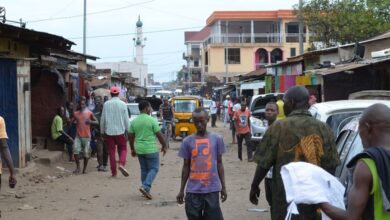
Mauritanian Government Tightens Measures To Contain Spread Of Covid-19
The Mauritanian government on Friday tightened measures to contain the spread of COVID-19 in the country as the number of…
Read More » -
Burkina Faso
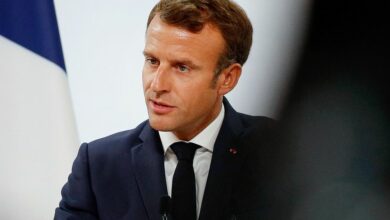
France To Begin Withdrawal Of Military Troops From Africa’s Sahel Region
France will begin withdrawal of its military troops from the Sahel region of West Africa before the end of the…
Read More » -
Mauritania

Mauritania Receives First COVID-19 Vaccine Shipment Via France Donation
Mauritania received its first shipment of COVID-19 vaccines donated by Europe and delivered through the COVAX initiative on Monday at…
Read More » -
Mauritania
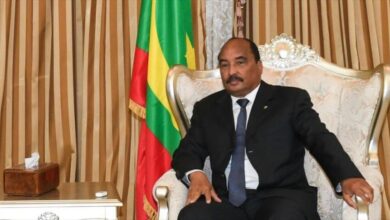
Mauritania: Former President Abdel Aziz Claims His Innocence In Corruption Inquiry
Mauritania’s former President Mohamed Ould Abdel Aziz has come forward to prove his innocence over suspected embezzlement, reported Africa News.…
Read More » -
Mauritania
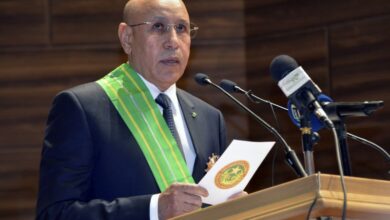
Mauritania: President Mohamed Ould Ghazouani Appoints New Government
Mauritania’s President Mohamed Ould Ghazouani on Sunday appointed a new government after the names of some of his ministers appeared…
Read More » -
Mauritania
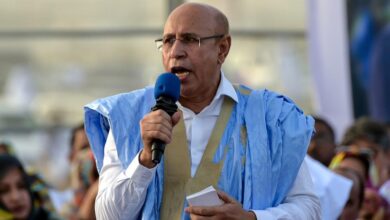
Mauritanian President Ghazouani Appoints Mohamed Ould Bilal As New PM
Mauritanian President Mohamed Ould Ghazouani on Thursday announced veteran public administrator Mohamed Ould Bilal as the country’s prime minister, reported…
Read More » -
Mauritania

France Vows To Deploy 600 Additional Military Troops To Africa’s Sahel Region
France on Sunday announced plans to boost its military presence in West Africa, by deploying 600 troops in Mali and…
Read More » -
Eswatini
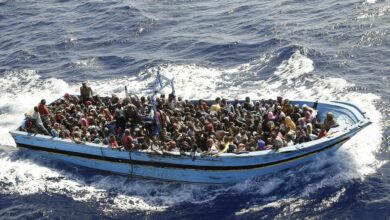
At least 58 Feared Dead As Packed Migrant Boat Capsizes Off Mauritania Coast: UN
At least 58 people are feared to have drowned after a boat carrying dozens of migrants capsized in the Atlantic…
Read More »

